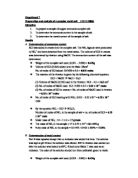Plan to investigate the transition temperature of salt hydrates
Transition Temperatures Of Salt Hydrates
For my investigation, I am attempting to investigate the transition temperatures of salt hydrates. Trying to identify the transition temperature, and what affects them. I shall experiment on a salt hydrate and produce a graph of results. I shall do this for all salt hydrates I am testing.
Salts are chemical compounds that always contain two things: Cation’s and Anion’s Cation’s are positively charged particles (for example a lithium ion or a hydrogen nucleus). The other things are anion’s. Anion’s are negatively charge particles (for example a chlorine ion or a fluorine ion). Salts are ionic compounds that contain a lattice structure of these charged particles. Salts are ionic compounds and thus they are soluble in water, this is due to the water molecules being polar and these molecules effectively dismantle the ionic lattice, by pulling the ion’s (like pulling blocks out of a jenga tower) [1]. When molten or in a solution, salts can conduct electricity, this is because the individual ion’s can move. Charge can therefore be transferred from one area to the other, meaning liquid or aqueous salts are electrically conductive. The body uses salt’s as ‘electrolytes’ to transfer electrical charge from one area to another. This includes along the conductive tissue found in the heart, initiating a heartbeat or opening pores in a cell membrane allowing molecules in or out of the cell [2].
Salt hydrates are salt molecules surrounded by water molecules. The water molecules are made up of an oxygen molecule bonded to 2 hydrogen molecules. The oxygen molecule has a higher electronegativity and thus the electrons around the molecule are attracted to the oxygen more than the hydrogen. Thus the molecule has a slight negative charge over the oxygen and positive charge over the hydrogen’s. The water molecules are then attracted to cation’s and anion’s respectfully . The water molecules are bonded to the salt molecules by intermolecular forces which aren’t as strong as the bonds between individual atoms. This explains why the salt can be heated and the water molecules can evaporate from the hydrate, forming an anhydrous salt (or a salt dehydrate). When the compound is heated, water will evaporate away from it, causing a dehydrate to be formed. This will have a molecular mass of just the salt as it is just the salt. But if you pass water vapour over the salt, it will absorb any water returning to a salt hydrate. This will now have the Molecular mass of the salt plus the molecular mass of the water. To form a slat hydrate, you must place the dehydrate salt in water and then heat gently to evaporate the excess water. The crystals you are left with will now be the hydrated salt. To write a salt hydrate you first write the salt formula followed by a dot, followed by how many water molecules are combined to one unit of salt. An example:- CuSO4·5H2O [3]. This shows there are 5 water molecules for every one copper sulphate molecule. The name of this molecule would be Copper Sulphate Pentahydrate, so to name a salt hydrate, you first write the salt, followed by the prefix which is linked to the number (mono-1, di-2, tri-3…) followed by hydrate.








